Appliances
How to Block Light From Top of Curtains
2025

When it comes to blocking light from the top of curtains, it can seem almost impossible to keep the sun out with just your hands. But don’t worry, there are various effective ways to overcome this problem.
From utilizing curtain rods with a wraparound design to adding a pelmet or valance, we've got you covered.
So, if you've been struggling to find a solution to keep unwanted light from creeping in, stick around to discover some innovative techniques that will transform your space into a serene sanctuary.
Key Takeaways
- Curtain rods with wraparound design prevent light from seeping through the sides, creating a cozy and serene atmosphere.
- Blackout curtain liners enhance the light-blocking capabilities of curtains, with options such as polyester, cotton, and microfiber.
- Pelmets or valances add style and serve a practical purpose, blocking light, concealing curtain rods, and providing a polished look.
- Secure mounting surfaces and appropriate hardware, like sturdy curtain rods or tracks, wall anchors or brackets, and ceiling-mounted tracks, ensure effective light blocking and prevent damage to walls.
Use Curtain Rods With Wraparound Design
We found that using curtain rods with a wraparound design significantly improved light blocking in our home. The wraparound design allows the curtains to hug the wall, preventing light from seeping through the sides. This practical solution not only enhances light blocking but also adds a stylish touch to the room.
By using curtain rods with a wraparound design, we were able to effectively block out unwanted light, creating a cozy and serene atmosphere in our living spaces. This method not only serves a functional purpose but also adds an element of sophistication to the room's decor. It's a simple yet effective way to elevate the ambiance of any space while maintaining a mastery of light control.
Additionally, these curtain rod alternatives offer a versatile solution for various window treatments, allowing for seamless integration into any room design. With the right choice of curtain fabric and color, this method can enhance the overall aesthetic appeal of the room while providing exceptional light blocking capabilities.
Install Blackout Curtain Liners

To enhance the light-blocking capabilities of your curtains, consider installing blackout curtain liners for a practical and stylish solution. Blackout curtain liners are an excellent way to upgrade your existing curtains and effectively block out light. When selecting blackout curtain liners, it's important to consider the light blocking fabric choices to ensure maximum performance. Here are some popular fabric choices for blackout curtain liners:
| Fabric | Description | Benefits |
|---|---|---|
| Polyester | Durable and affordable, easy to maintain | Excellent light blocking properties |
| Cotton | Natural feel, breathable | Provides good insulation and privacy |
| Microfiber | Luxurious texture, wrinkle-resistant | Blocks light and reduces outside noise |
Choosing the right blackout curtain liner fabric depends on your specific needs and preferences. Whether you prioritize light blocking, insulation, or texture, there is a suitable fabric for you. By carefully selecting blackout curtain liners with the right fabric, you can effectively control the amount of light entering your space while adding a touch of style to your home.
Add a Pelmet or Valance
Let's talk about adding a pelmet or valance to your curtains!
These decorative elements not only add a touch of style to your windows but also serve a practical purpose.
We'll explore the function of a pelmet, the benefits of a valance, and share some tips for installation to help you achieve the perfect look for your space.
Pelmet Function
Enhancing the functionality and aesthetic appeal of curtains can be achieved by adding a pelmet or valance. These additions provide a stylish solution for blocking light and adding a touch of practical elegance to your window treatments.
When considering pelmet function, it's essential to focus on the design and materials used for effective light blocking. Here are some key considerations:
- Pelmet Design: Choose a pelmet design that complements your curtains and overall interior decor. Consider tailored, box-pleated, or gathered pelmet styles for a classic or modern look.
- Light Blocking Materials: Opt for dense fabrics such as velvet, suede, or tightly woven cotton to effectively block light from the top of your curtains.
- Customization: Explore custom pelmet options to perfectly fit your window dimensions, ensuring maximum light blockage and a seamless, polished appearance.
Valance Benefits
Exploring the benefits of adding a valance or pelmet to your curtains, we can enhance both the light-blocking functionality and the visual appeal of our window treatments.
Valances come in various styles such as tailored, scalloped, swag, or gathered, allowing us to personalize our window decor. These versatile additions not only block light from the top of the curtains but also conceal the curtain rods, giving a polished and cohesive look to the entire window treatment.
When considering valance materials, options like cotton, linen, silk, or velvet provide both style and functionality. Additionally, valances can add a pop of color or texture, elevating the overall aesthetic of the room.
Installation Tips
To enhance the light-blocking functionality and visual appeal of your curtains, consider adding a pelmet or valance for a polished and cohesive window treatment. When it comes to curtain hanging, incorporating a pelmet or valance can provide a more structured and tailored look to your window space.
These additions not only offer an elegant finishing touch but also aid in light control by preventing rays from seeping in through the top of the curtains. Additionally, pelmets or valances can help conceal the curtain rods or tracks, creating a more streamlined and sophisticated appearance.
Utilize Tension Rods Above the Curtains
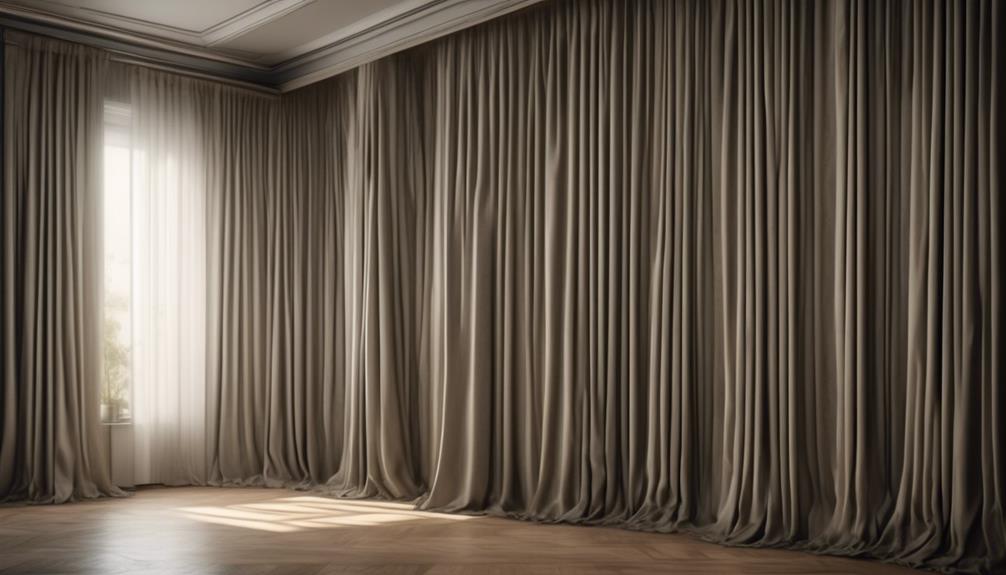
One effective way to block light from curtains is by utilizing tension rods placed above the curtains to create a seamless and stylish light-blocking solution. Tension rods, a versatile piece of curtain hardware, can be easily adjusted to fit the width of your window, and they provide a sturdy base for light control solutions.
When using tension rods to block light from the top of curtains, it's important to choose a blackout curtain that's slightly longer than the window frame. This ensures that no light seeps through the top, creating an effective barrier against unwanted sunlight or streetlights at night.
To achieve optimal light control with tension rods, consider layering your curtains with a sheer or decorative panel in front of the blackout curtain. This not only adds a stylish touch to your window treatment but also offers flexibility in adjusting the amount of natural light entering the room.
Additionally, tension rods can support various curtain styles, from traditional to modern, making them a practical choice for anyone seeking a tailored and efficient solution for blocking light from the top of curtains.
Attach Adhesive Hook-And-Loop Tape
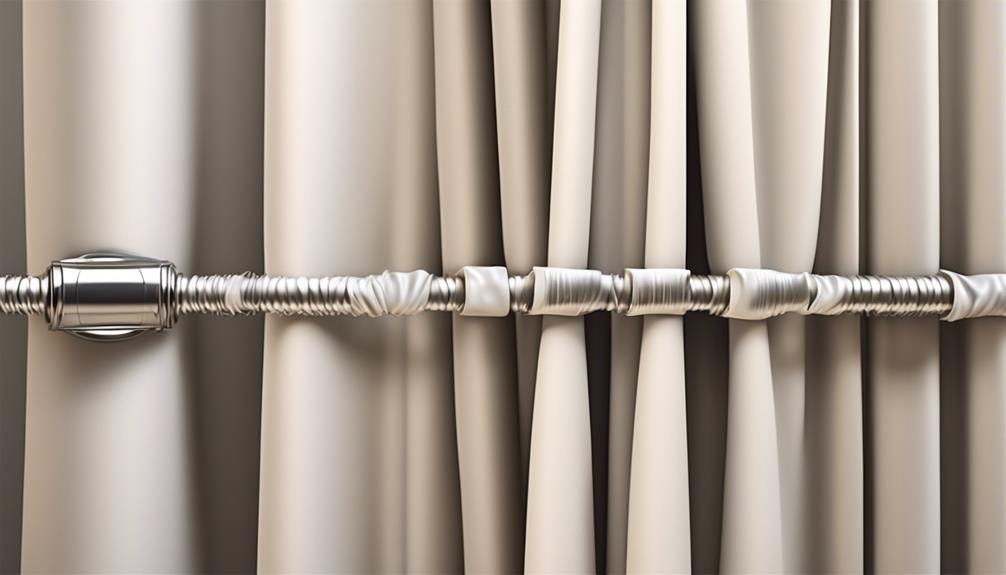
So, let's talk about attaching adhesive hook-and-loop tape to your curtains.
This method is a game-changer when it comes to blocking out light and creating a cozy atmosphere in your space.
We'll explore the effectiveness of this tape and how it can transform your curtains into a light-blocking powerhouse.
Tape Attachment Method
We found that attaching adhesive hook-and-loop tape to the curtains was a simple and effective way to block out light. The tape can be easily attached to the top of the curtains, allowing for seamless light control.
Here are some practical tips for using this method:
- Ensure that the adhesive hook-and-loop tape is firmly attached to both the curtains and the mounting surface to prevent light leakage.
- Consider using blackout fabric or curtains in combination with the tape for enhanced light blockage, especially in bedrooms or home theaters.
- For a stylish touch, choose hook-and-loop tape in a color that matches your curtains, or even consider decorative options to seamlessly blend with your decor.
Light-Blocking Effectiveness
Using adhesive hook-and-loop tape to block out light provides a practical and stylish solution for controlling the amount of natural light entering a room.
When paired with light blocking fabric, this method can significantly reduce the amount of light that filters through the top of curtains.
The adhesive hook-and-loop tape creates a secure seal, preventing light from seeping through any gaps between the fabric and the window frame.
This combination offers an effective alternative to traditional window treatments, such as blackout curtains or blinds, providing a customizable option for light control.
The versatility of this approach allows for easy adjustments, making it an ideal choice for those seeking a tailored solution for managing natural light.
Hang Curtain Rings With Clips
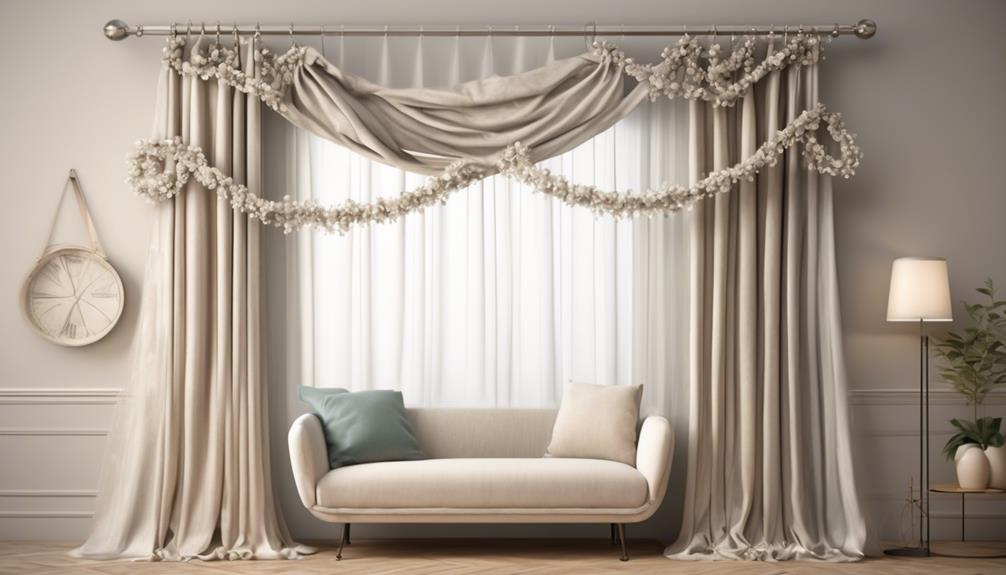
Securing curtain rings with clips provides a practical and stylish solution for blocking light from curtains. When it comes to hanging curtain rings with clips, there are various clip options and alternative solutions available.
Some popular clip options include metal rings with clips, wooden rings with clips, and plastic rings with clips. Additionally, alternative solutions such as curtain hooks or fabric tabs can be used for hanging curtains effectively.
When hanging curtain rings with clips, it's important to consider the hanging techniques and fabric considerations. The hanging technique should ensure that the clips securely hold the curtains in place without causing any damage to the fabric. Fabric considerations include the weight and thickness of the curtains, as different fabrics may require different clip styles for optimal hanging.
In mastering the art of hanging curtain rings with clips, it's essential to explore various clip options, alternative solutions, hanging techniques, and fabric considerations to achieve the desired light-blocking effect while adding a touch of style to the room.
Apply Fabric Glue to Attach an Additional Fabric Layer

To further enhance the light-blocking effect and add a touch of elegance to the curtains, consider applying fabric glue to attach an additional fabric layer. This technique not only improves the curtains' light-blocking capabilities but also provides an opportunity to introduce new textures and colors to the room's decor.
When selecting the additional fabric layer, opt for a dense, opaque material that complements the existing curtains. Once you have chosen the fabric, lay it flat and measure it to match the dimensions of the curtains.
Carefully apply fabric glue along the edges of the new fabric layer and press it firmly onto the backside of the curtains. Ensure that the glue is evenly distributed to prevent any lumps or bumps in the fabric. Once the fabric layer attachment is complete, allow sufficient time for the glue to dry before hanging the curtains.
This innovative approach not only blocks out unwanted light but also transforms your curtains into a sophisticated and customized window treatment, showcasing your mastery of light-blocking techniques.
Employ Magnetic Curtain Tiebacks
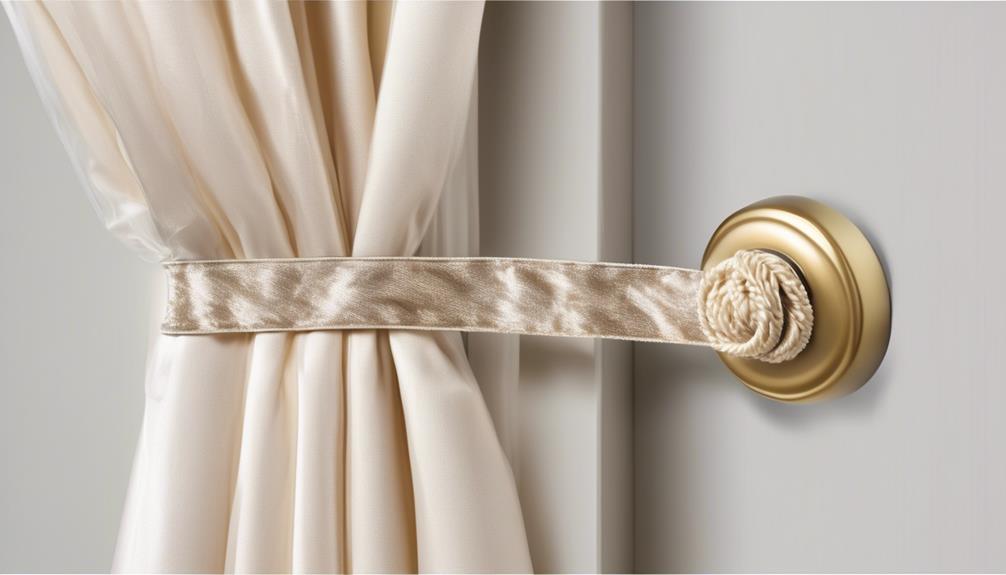
Let's talk about the ingenious solution of magnetic curtain tiebacks.
These nifty accessories not only keep your curtains tidy and stylish, but they also help control the amount of light entering your space.
We'll also share some installation tips to make the process a breeze.
Magnetic Tieback Benefits
When looking to add practical and stylish functionality to your curtains, consider employing magnetic curtain tiebacks for effortless light control and a modern touch to your decor.
Magnetic tiebacks offer several benefits that make them a great choice for any home:
- Versatility: Magnetic tiebacks provide a versatile alternative to traditional tiebacks and decorative hooks, allowing for easy adjustment and positioning to achieve the desired look and light control.
- Easy Maintenance: With material options such as metal or fabric, magnetic tiebacks are easy to clean and maintain, ensuring they always look their best while complementing your curtains.
- Modern Elegance: The sleek and contemporary design of magnetic tiebacks adds a touch of modern elegance to your space, elevating the overall aesthetic appeal of your curtains and room decor.
Installation Tips
As we explore the best practices for installing magnetic curtain tiebacks, we can leverage the versatility and modern elegance they offer to enhance both the functionality and aesthetic appeal of our curtains. When it comes to curtain hardware, magnetic tiebacks provide a sleek and practical solution for light control. To ensure a successful installation, follow these tips:
| Installation Tips | Description | Benefits |
|---|---|---|
| Locate the Ideal Position | Identify the perfect placement to hold curtains securely | Prevents light gaps |
| Secure Mounting Surface | Ensure the surface can support the magnetic tiebacks | Prevents damage to walls |
| Adjust for Curtain Weight | Customize the distance between tiebacks and curtains | Allows for optimal light control and aesthetics |
Employing magnetic curtain tiebacks not only enhances the overall look of the room but also provides effective light control, making them an essential addition to any curtain setup.
Install a Curved Curtain Rod

To achieve a more elegant and functional look for your curtains, consider installing a curved curtain rod. A curved curtain rod offers a unique and stylish solution to block light from the top of your curtains while adding a touch of sophistication to your space.
Here are some reasons why a curved curtain rod might be the perfect choice for your window treatment:
- Enhanced Light Blocking: The curvature of the rod allows the curtains to wrap around the sides, preventing light from seeping through the top and sides of the window, providing better light control and privacy.
- Unique Aesthetic Appeal: Curved curtain rods add a distinctive and elegant look to your windows, creating a visually appealing and luxurious ambiance in any room.
- Versatile Design Options: With customizing curtain rods, unique options are available to fit various window shapes and sizes, allowing you to achieve a tailored and polished appearance for your window treatments.
Use Tension Wire or Cable
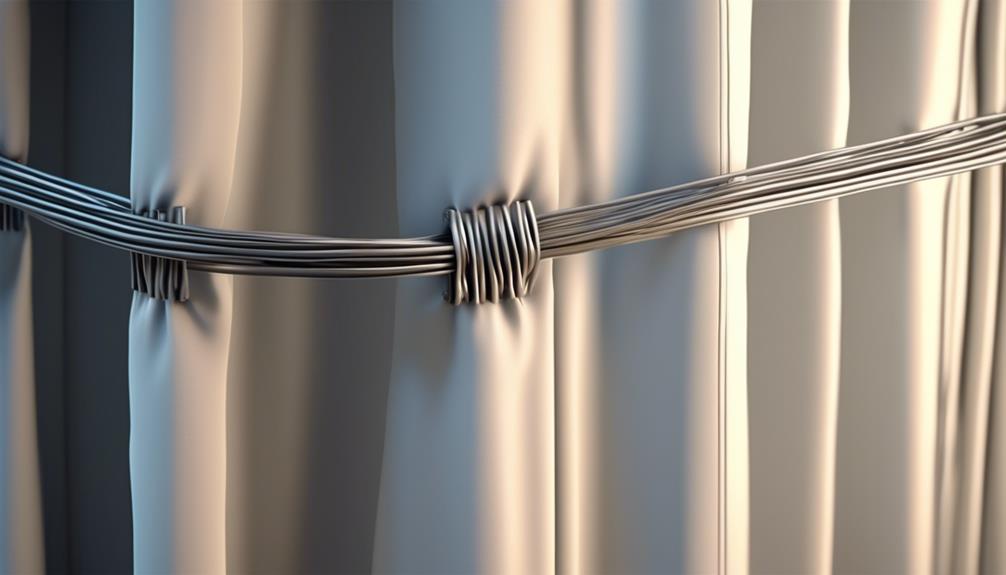
Let's talk about the benefits of using tension wire or cable for blocking light from curtains.
We'll cover the various options for attaching curtains to the wire and share some practical tips for installation.
Tension wire offers a sleek and modern solution for achieving a clean, light-blocking look in any room.
Tension Wire Benefits
Using a tension wire or cable for your curtains offers a sleek and modern solution for keeping light out and enhancing the overall look of your space.
The benefits of using tension wire for curtains include:
- Versatility: Tension wire allows for easy customization, making it suitable for various window sizes and shapes.
- Minimalistic Appeal: Its minimal design seamlessly blends with any interior decor, providing a clean and uncluttered look.
- Enhanced Privacy: Tension wire ensures maximum coverage, effectively blocking out light and maintaining privacy in your rooms.
These benefits make tension wire an attractive choice for those seeking tension wire alternatives and effective light blocking solutions. It's a practical and stylish option for mastering light control in your home.
Curtain Attachment Options
We've discovered the benefits of using tension wire for curtains, but now let's explore the various curtain attachment options, including the use of tension wire or cable.
When it comes to curtain attachment alternatives, creative solutions abound. Tension wire offers a sleek and modern look, allowing for a clean, unobtrusive way to hang curtains. Alternatively, cable systems provide innovative options for hanging curtains, giving you the flexibility to create unique and dynamic light blocking accessories.
These attachment options not only serve a practical purpose but also offer a stylish way to enhance the overall aesthetic of your space. Whether you opt for tension wire or cable, both options provide a versatile and durable solution for hanging curtains while ensuring effective light blocking and privacy.
Installation Tips
For a sleek and modern installation of curtains, consider using tension wire or cable for a clean and unobtrusive look that enhances the overall aesthetic of your space. When using tension wire or cable for curtain attachment, it's essential to ensure proper installation for effective light blocking solutions.
Here are some tips for utilizing tension wire or cable:
- Proper Anchoring: Ensure that the tension wire or cable is securely anchored to the walls to support the weight of the curtains and maintain the desired tautness.
- Even Distribution: Distribute the tension evenly across the wire or cable to prevent sagging and ensure a polished appearance.
- Sturdy Hardware: Select high-quality hooks and brackets to facilitate a strong and reliable attachment for the tension wire or cable.
Add a Cornice Board

To enhance the appearance and functionality of your curtains, consider adding a stylish cornice board above the window. Cornice boards not only offer a sophisticated touch to your window treatments but also provide a practical solution for blocking light from the top of curtains.
However, if you're looking for alternatives to traditional cornice boards, creative solutions like fabric-wrapped foam boards or wooden valances can achieve a similar effect with a unique twist. Customizing cornice boards also opens a realm of design ideas. Experiment with different fabrics, trims, and paint colors to match your interior décor and create a cohesive look. You can even add embellishments such as tassels, beads, or decorative hardware to elevate the visual appeal of your cornice board.
Whether you opt for a classic cornice board or decide to venture into more unconventional alternatives, the addition of a cornice board not only blocks light effectively but also adds a touch of elegance and personality to your window treatments.
Utilize a Ceiling-Mounted Curtain Track

Installing a ceiling-mounted curtain track offers a sleek and modern solution for effectively blocking light and maximizing the functionality of your window treatments. The ceiling mounted track provides a clean and unobtrusive appearance, allowing for seamless integration with various decor styles. Additionally, it offers customization options, allowing you to choose the perfect track style, color, and accessories to complement your space. When considering light blocking efficiency, a ceiling-mounted track ensures that curtains can be drawn all the way across the window, minimizing light gaps and enhancing privacy.
- Customization Options: With a ceiling-mounted track, you can select from a variety of track styles and colors, as well as add accessories such as decorative finials or tiebacks to personalize your window treatments.
- Light Blocking Efficiency: The ceiling-mounted track allows curtains to be fully extended, providing maximum coverage and minimizing light gaps, thus optimizing the light blocking efficiency of your window treatments.
- Maintenance Tips: Regularly inspect the track for any dust or debris accumulation and clean it with a soft cloth or brush to ensure smooth operation and longevity.
Attach a Tension Rod Pocket Organizer

After maximizing the functionality of our window treatments with a ceiling-mounted curtain track, we can further enhance our light blocking capabilities by attaching a tension rod pocket organizer. This innovative method allows for additional curtain attachment, providing increased light control and organization. By incorporating a tension rod pocket organizer, we can efficiently block light from the top of curtains while adding a stylish element to our window treatments.
| Curtain Attachment | Light Control |
|---|---|
| Versatile | Blocks out light |
| Easy to install | Reduces glare |
| Adds decorative touch | Enhances privacy |
The tension rod pocket organizer offers a versatile solution for curtain attachment, accommodating various curtain styles and fabrics. Its ease of installation makes it a practical choice for those seeking to efficiently manage light control in their living spaces. Additionally, the decorative element of the organizer adds a stylish touch to the overall window treatment, enhancing the aesthetic appeal of the room while serving a functional purpose. Overall, attaching a tension rod pocket organizer is a practical and stylish way to optimize light control and organization within the home.
Install a Top-Mounted Roller Blind

For optimal light control and a sleek window treatment, consider incorporating a top-mounted roller blind. Roller blinds offer several benefits and can significantly enhance the light-blocking effectiveness of your window treatments.
Here are some installation tips and advantages to keep in mind:
- Versatile Light Control: Roller blinds provide the flexibility to adjust the amount of light entering the room, allowing you to create the perfect ambiance for any time of day.
- Space-Saving Alternative: Unlike traditional curtain rods, roller blinds offer a space-saving solution, making them ideal for windows with limited space or when you want to maintain a minimalist aesthetic.
- Enhanced Privacy: With their light-blocking effectiveness, roller blinds ensure privacy while still allowing natural light to filter through, offering the best of both worlds.
When installing a top-mounted roller blind, ensure that it's securely mounted to prevent any sagging or misalignment. Additionally, consider the material and color of the blind to complement your existing decor while maximizing its light-blocking capabilities.
Frequently Asked Questions
Can I Use These Methods to Block Light From the Top of Sheer Curtains?
Yes, you can use these methods to block light from the top of sheer curtains.
Sheer curtain alternatives like blackout liners or light blocking fabric choices such as thermal curtains work effectively to prevent light from seeping in.
Will These Methods Work for Windows With an Unusual Shape or Size?
Custom solutions are essential for windows with unusual shapes or sizes. Window film offers a stylish option to block light and can be tailored to fit any window. For those seeking professional installation, it's a great choice.
However, for those who prefer a hands-on approach, there are also DIY alternatives available. It's important to weigh the options and choose the best solution for your unique window situation.
Are There Any Safety Considerations to Keep in Mind When Using Tension Rods Above the Curtains?
When using tension rods above the curtains, safety precautions are crucial. Ensure the rods are securely anchored to prevent accidents.
For installation tips, measure the width accurately and use appropriate-sized rods.
As for material options, consider sturdy and durable rods that can support the weight of the curtains.
For maintenance, periodically check the rods for stability and tighten any loose fittings. This ensures a safe and functional setup for blocking light from the top of curtains.
How Do I Choose the Right Blackout Curtain Liners for My Existing Curtains?
When choosing the right blackout curtain liners, we prioritize light-blocking effectiveness. Look for liners that offer a high level of opacity to effectively block out unwanted light.
Consider the material and thickness of the liner to ensure it complements your existing curtains.
Additionally, seek out liners that are easy to install and maintain.
Can I Combine Multiple Methods to Achieve Maximum Light-Blocking Effectiveness?
Absolutely, we can achieve maximum light-blocking by layering curtains and customizing blinds.
Layering blackout curtains with sheer ones, or adding a blackout liner to existing curtains, can enhance light-blocking effectiveness.
Additionally, customizing blinds with light-blocking features can further improve the overall blackout effect.
Conclusion
In conclusion, blocking light from the top of curtains can be achieved through a variety of creative and practical methods. Whether it's using wraparound curtain rods, blackout liners, or tension rod pocket organizers, there are plenty of stylish solutions to keep unwanted light out.
With these tips, you can create a cozy and comfortable atmosphere in your home while adding a touch of charm and character to your windows.
- About the Author
- Latest Posts
Introducing Ron, the home decor aficionado at ByRetreat, whose passion for creating beautiful and inviting spaces is at the heart of his work. With his deep knowledge of home decor and his innate sense of style, Ron brings a wealth of expertise and a keen eye for detail to the ByRetreat team.
Ron’s love for home decor goes beyond aesthetics; he understands that our surroundings play a significant role in our overall well-being and productivity. With this in mind, Ron is dedicated to transforming remote workspaces into havens of comfort, functionality, and beauty.
Garage Door Opener
DIY: Install Garage Door Opener Keypad in 10 Steps
Journey into seamless garage access with our 10-step guide to installing a keypad – unlocking convenience at your fingertips.

When it comes to improving the functionality of your garage door system, adding a keypad can offer a convenient way to enter your garage.
However, the process of installing one might seem daunting at first glance. But fear not, as we have broken down the steps into a clear and concise guide that will have you confidently tackling this project in no time.
Stay tuned for essential tips and tricks that will ensure a smooth installation process and have you enjoying the convenience of your newly installed keypad in no time.
Key Takeaways
- Plan and prepare tools and location for keypad installation with attention to accessibility and visibility.
- Protect the keypad from weather elements with proper positioning and a weatherproof cover.
- Program the keypad securely, ensuring alignment and stability for optimal performance.
- Verify wiring connections, test the keypad's functionality, and finalize installation with thorough checks for proper operation.
Gather Required Tools and Materials
To begin the installation process smoothly, ensure we've all the necessary tools and materials at hand, such as a screwdriver, screws, and the keypad itself. When gathering these items, make sure they're compatible with your specific garage door opener model. It's crucial to have everything organized and easily accessible outside the garage where the installation will take place. Check the contents of the keypad box to confirm all components are included, avoiding any setbacks during the setup. Having a stable surface to lay out the tools and materials will facilitate quick access and prevent any potential mishaps.
Proper preparation is key to a successful installation. By ensuring we've the correct tools and materials ready beforehand, we can make the process more efficient and eliminate unnecessary delays. By double-checking and gathering all necessary items outside the garage, we set the stage for a smooth and hassle-free installation of the garage door opener keypad.
Locate the Ideal Placement

When choosing the ideal placement for your garage door opener keypad, we need to consider a few key points.
Ensure the keypad is strategically positioned for easy access by all users, at a comfortable height.
Additionally, think about weather protection to prolong the keypad's lifespan.
Choose Strategic Position
For optimum accessibility and ease of use, position the keypad at a height that caters to both adults and children while ensuring comfortable operation.
When choosing the strategic position for the garage door opener keypad, consider installing it at a level that's easily reachable for all users. Ensure the keypad isn't too high or too low, allowing for convenient operation without straining or bending.
Take note of any potential obstructions or interferences in the selected mounting location to avoid issues with functionality. Additionally, aim to place the keypad in a well-lit area that provides clear visibility for entering the pin code, enhancing user experience and security.
Consider these factors to determine the ideal placement for the keypad to optimize its functionality within your garage.
Ensure Easy Access
Positioning the garage door opener keypad at a height accessible to all users, typically around 5 feet from the ground, ensures convenient and easy access for efficient operation.
Placing the keypad in a well-lit area enhances visibility, especially during nighttime use. Be mindful of obstructions or sharp edges that could obstruct the keypad's functionality and accessibility.
Opt for a location shielded from extreme weather conditions to prolong the keypad's lifespan. Validate the keypad's placement by testing it from various entry angles to guarantee effortless access.
Consider Weather Protection
After ensuring easy access for efficient operation, the next crucial step is to consider weather protection when locating the ideal placement for your garage door opener keypad. To shield the keypad from direct exposure to rain, snow, or extreme weather conditions, it is advisable to install it in a sheltered area. Look for spots under an eave or a covered porch to extend the keypad's lifespan. If mounting the keypad in an exposed area, consider weatherproofing it with a protective cover or housing. Choosing a location that minimizes contact with water and moisture is key to prevent damage and maintain functionality over time. Ensuring weather protection for the keypad is essential for outdoor installations to uphold performance and longevity.
| Placement | Protection |
|---|---|
| Under an eave | Shield from rain and snow |
| Covered porch | Protection from extreme weather |
| Weatherproof cover | Prevent direct exposure to moisture |
Prepare the Keypad Mounting Surface

To ensure a secure and professional installation, start by cleaning the mounting surface with a damp cloth to remove any dirt or debris that may affect the keypad's adherence.
Once the surface is clean, use a level to ensure it's flat before proceeding with the installation. This step is crucial in achieving a polished and secure finish for your keypad.
Additionally, consider using a stud finder to locate and mark the studs on the wall. This will provide added support when mounting the keypad, ensuring it stays securely in place.
It's important to avoid mounting the keypad near any moving parts of the garage door to prevent interference or damage during operation.
Lastly, double-check the mounting surface for stability and suitability before proceeding with the installation to avoid any potential issues down the line.
Following these steps will help you set up your keypad efficiently and effectively.
Install Batteries in the Keypad

Let's start by checking the keypad manual for the specific 9-volt battery needed and opening the battery compartment accordingly.
Make sure to insert the battery following the polarity markings inside the compartment and securely close it for proper functionality.
Testing the keypad afterward will confirm the correct installation of the battery and ensure the keypad is ready for use.
Battery Installation Process
For optimal keypad performance, ensure the correct batteries are installed according to the manufacturer's specifications. Here's how to install the batteries properly:
- Check the Keypad Manual: Look up the specific battery requirements, typically 9-volt or AAA batteries, in the manual.
- Open the Battery Compartment: Use a screwdriver or follow the keypad's sliding mechanism to access the battery compartment.
- Insert Batteries Correctly: Pay attention to the polarity markings inside the compartment and insert the batteries accordingly.
- Securely Close the Compartment: Ensure the battery compartment is closed securely to establish proper connection and functionality.
Remember to replace the batteries periodically to maintain peak performance for your keypad.
Powering Up the Keypad
After successfully installing the batteries in the keypad, the next step is to power up the device by closing the cover securely to ensure proper functionality. To emphasize the importance of battery maintenance and replacement, here is a table outlining key points:
| Battery Maintenance Tips | |
|---|---|
| 1. Check battery life regularly | 2. Ensure proper polarity alignment |
| 3. Replace batteries promptly when low | 4. Avoid mixing old and new batteries |
| 5. Keep the battery compartment clean and dry | |
Following these guidelines will help maintain the keypad's efficiency and prevent operational issues. Remember, a well-powered keypad is essential for seamless garage door opener functionality.
Program the Keypad With Your Opener

To program the keypad with your opener, locate the colored learn button near the motor unit of the garage door opener. Different colors of learn buttons indicate specific programming methods for the keypad. Follow the manufacturer's instructions, as they typically involve a sequence of button presses to initiate programming mode.
Here are the steps to program the keypad accurately:
- Identify the color of the learn button on your garage door opener.
- Enter the programming mode by pressing the designated buttons on the keypad.
- Input a four-digit pin that you'll use to operate the keypad.
- Press the learn button on the garage door opener to synchronize the keypad with the opener.
It is crucial to test the programmed keypad by entering the pin and operating the garage door. This ensures successful synchronization and allows you to verify that the keypad is working correctly with your garage door opener.
Secure the Keypad in Place

Let's ensure the keypad is securely fastened in place by carefully aligning it with the level before tightening the screws evenly. Ensuring the keypad is straight is crucial to prevent any future issues, such as misalignment or difficulties in using the keypad. Here is a handy table to guide you through securing the keypad:
| Step | Action |
|---|---|
| 1 | Use a level to check alignment. |
| 2 | Tighten screws evenly for stability. |
| 3 | Confirm snug fit against the wall. |
Connect the Wiring to the Opener

Let's now tackle the crucial step of connecting the wiring to the opener.
We'll provide an overview of the wiring connections, ensure proper wire termination, and test the connection for functionality.
This process is vital to ensure your keypad communicates effectively with the garage door opener.
Wiring Connections Overview
Before proceeding with the wiring connections for the keypad installation, ensure that the power to the garage door opener is turned off.
Here's an overview of the wiring connections process:
- Identify the terminals on the garage door opener where the keypad wiring will be connected.
- Match the keypad wires to the corresponding terminals on the opener based on the installation instructions.
- Use wire nuts to securely connect the keypad wires to the opener terminals for a reliable connection.
- Double-check the wiring connections to ensure they're properly seated and insulated before restoring power to the opener.
Proper Wire Termination
Have the wire strippers handy to carefully remove the insulation from the ends of the keypad wires before matching them to the corresponding terminals on the garage door opener.
Ensure to match the colors of the keypad wires to the designated terminals on the opener.
Insert each wire into its assigned terminal and securely tighten the screws to establish a reliable connection.
It's crucial to double-check all connections to confirm there are no loose wires or exposed copper, which could lead to electrical hazards.
Adhering to the manufacturer's guidelines for wire termination is essential to prevent any operational issues.
Following these steps diligently will help guarantee a safe and efficient installation of your garage door opener keypad.
Testing the Connection
After securely connecting the keypad wiring to the designated terminals on the garage door opener, the next crucial step is to test the connection to ensure proper functionality before finalizing the installation. Here are four essential steps to follow:
- Activate the Keypad: Press a few random numbers on the keypad to check if the display lights up and responds.
- Test with the Opener: Enter the access code followed by the open/close button to see if the garage door responds accordingly.
- Check for Consistency: Repeat the process multiple times to confirm consistent operation.
- Inspect for Errors: Look for any error codes or unusual behavior during testing to address any potential issues promptly.
Test the Keypad Functionality

To ensure the smooth operation of the keypad, thoroughly test its functionality by pressing all buttons to confirm responsiveness and entering the programmed PIN for seamless garage door control. When testing the keypad, ensure that each button responds promptly and accurately to your touch. Next, input the programmed PIN to verify that the garage door opens and closes as intended. Additionally, check if the keypad illuminates correctly for easy use in different lighting conditions. Look out for any error messages or beeping sounds that could signal problems with programming or connectivity. Evaluate the keypad's range by testing its operation from various distances to guarantee reliable performance.
| Keypad Functionality Test | ||
|---|---|---|
| Button Responsiveness | Programmed PIN Entry | Illumination Check |
| Error Message Detection | Range Evaluation |
Adjust Keypad Settings as Needed

Let's seamlessly continue our installation process by adjusting the keypad settings as needed for added security and convenience. Here are some essential adjustments you may want to consider:
- Change Pin Code: Enhance security by customizing the four-digit pin code on the keypad regularly.
- Customize Features: Take control of additional garage door opener features, such as lights, by customizing the keypad settings to suit your preferences.
- Time Delay Feature: Prevent accidental activation of the garage door opener by setting up a time delay feature on the keypad.
- Vacation Mode: Enable vacation mode on the keypad to disable remote access when you're away for an extended period, enhancing the security of your garage.
Remember to refer to the manufacturer's instructions for adjusting advanced settings on the keypad to ensure optimal performance.
Enjoy Your Newly Installed Keypad

Upon completing the installation of your new keypad, take a moment to familiarize ourselves with its functions and button layout for seamless operation. Understanding how each button corresponds to specific actions will enhance your experience with the keypad.
Test its functionality multiple times to ensure it consistently works as expected. Consider setting up temporary access codes for guests or service providers to make entry more convenient.
It's essential to keep the keypad clean and free from debris to maintain its functionality over time. Remember to note down the keypad's location and pin code for future reference or troubleshooting purposes.
Frequently Asked Questions
Can I Add a Keypad to Existing Garage Door Opener?
Yes, we can add a keypad to an existing garage door opener. It's a straightforward process that enhances security and provides keyless entry.
Keypads work with various garage door opener brands and models. This upgrade is cost-effective and seamlessly integrates into your current setup with proper installation and programming.
Enjoy the convenience and peace of mind that a keypad brings to your garage door system.
Which Is Better Wired or Wireless Garage Door Keypad?
When it comes to choosing between a wired or wireless garage door keypad, it's essential to weigh the pros and cons.
Wired keypads offer reliability without battery reliance, but may need professional installation due to wiring requirements.
On the other hand, wireless keypads provide flexibility and are easier to install DIY.
Understanding your preferences and garage door opener setup will help determine which option suits you best.
Can You Hardwire a Garage Door Keypad?
Yes, we can hardwire a garage door keypad. It involves connecting the keypad directly to the power source of the garage door opener for a reliable power supply. Check the keypad's instructions to confirm hardwiring compatibility and follow the correct steps.
This method offers a more stable power source than batteries, but it may not be essential for all setups. Hardwiring is an option for those seeking a consistent power solution.
Can You Install a Garage Door Opener by Yourself?
Yes, we can install a garage door opener by ourselves. It's a manageable task with the right tools and instructions. Doing it independently can save us money and give us a sense of accomplishment.
Before starting, ensure the opener is compatible with our system. Following step-by-step guides is key to success. With attention to detail and patience, most of us can tackle this project successfully and enjoy the convenience of a keypad entry system.
Conclusion
In conclusion, with our 10-step guide, installing a garage door opener keypad can be a straightforward DIY project that adds convenience to your daily routine.
Remember, 'measure twice, cut once' to ensure accuracy and precision during the installation process.
By following our detailed instructions and taking your time to do it right, you can enjoy the benefits of easy access to your garage with just a few simple clicks.
Happy keypad installing!
- About the Author
- Latest Posts
Introducing Ron, the home decor aficionado at ByRetreat, whose passion for creating beautiful and inviting spaces is at the heart of his work. With his deep knowledge of home decor and his innate sense of style, Ron brings a wealth of expertise and a keen eye for detail to the ByRetreat team.
Ron’s love for home decor goes beyond aesthetics; he understands that our surroundings play a significant role in our overall well-being and productivity. With this in mind, Ron is dedicated to transforming remote workspaces into havens of comfort, functionality, and beauty.
Garage Door Opener
How Much a LiftMaster Garage Door Opener Costs
Unravel the enigmatic world of LiftMaster garage door opener costs, where affordability meets intricate functionality in surprising ways – a revelation awaits beyond.

When exploring the complex balance between cost and quality in the world of LiftMaster garage door openers, individuals may find themselves wading through a variety of choices, each with its own specific price point. The fascinating aspect is uncovering the detailed factors that influence these differing costs, revealing the elements that ultimately impact the financial commitment required.
So, as we embark on unraveling the mystery behind how much a LiftMaster garage door opener truly costs, prepare to uncover a world where functionality meets affordability in unexpected ways.
Key Takeaways
- LiftMaster garage door openers range from $200-$600, with most models priced between $250-$475.
- Features include WiFi connectivity, AC/DC motor options, battery backup, and automatic door locks.
- LiftMaster openers excel in functionality, convenience, and security, offering reliable quality.
- Consider drive mechanism, horsepower, smart capabilities, and installation costs when selecting a LiftMaster opener.
LiftMaster Chain Drive Opener Prices
LiftMaster chain drive garage door openers offer a range of prices, typically spanning from $200 to over $600, with most models priced between $250-$475, catering to various budgets and garage door needs. These openers come equipped with advanced features like WiFi and Smart technology, ensuring seamless integration with modern smart home setups. Customers can choose between models with AC and DC motors, providing options based on power and efficiency requirements. Additionally, the inclusion of battery backup in all 11 chain drive models ensures operation during power outages, adding an extra layer of convenience and security.
The affordability of LiftMaster chain drive openers doesn't compromise on performance. Despite the varying price points, each model is designed to deliver reliable functionality and durability. Factors like horsepower and security features contribute to the overall cost but ensure that customers receive a high-quality product tailored to their specific garage door demands. Noise reduction capabilities further enhance the user experience, making LiftMaster chain drive openers a practical and efficient choice for homeowners seeking a balance between cost and performance.
LiftMaster Belt Drive Opener Costs

Belt drive garage door openers from LiftMaster typically fall within the price range of $300 to $600, offering a balance between cost and performance for homeowners seeking a quieter operation. These openers are known for their smooth operation, making them a popular choice for those looking to reduce noise levels in their garage. Some key features of LiftMaster belt drive openers include rubber belts reinforced with steel, ensuring durability and reliability. Additionally, these models come with extension kits suitable for 8 or 10-foot doors, providing versatility for different garage configurations.
Key Points:
- Quiet Operation: LiftMaster belt drive openers offer a quieter alternative to chain drive models, making them ideal for homes where noise is a concern.
- Smooth Performance: The rubber belt design, reinforced with steel, ensures smooth operation, reducing friction and wear.
- Mid-Range Cost: Priced between $300 and $600, these openers strike a balance between affordability and performance, appealing to homeowners looking for quality at a reasonable price.
LiftMaster Wall-Mount Opener Prices
When considering garage door opener options for your home, wall-mount models from LiftMaster are priced between $500 to $600, offering a space-saving solution designed for high or irregular ceilings. These openers come equipped with features like direct drive operation, WiFi connectivity, and Smart technology, making them a convenient and secure investment for your household. The automatic door lock feature adds an extra layer of security to your garage. Below is a breakdown of LiftMaster wall-mount opener prices:
| Features | Description | Price Range |
|---|---|---|
| Direct Drive | Smooth and quiet operation | $500 – $600 |
| WiFi Connectivity | Control your garage door remotely | $500 – $600 |
| Smart Technology | Integration with smart home systems | $500 – $600 |
| Auto Door Lock | Enhanced security feature | $500 – $600 |
| Space-Saving | Ideal for high ceilings and irregular spaces | $500 – $600 |
LiftMaster Opener Features Breakdown

After exploring the pricing details of the LiftMaster wall-mount opener options, we'll now analyze the specific features that make these garage door openers stand out in the market.
LiftMaster Opener Features Breakdown:
- Smart Technology Integration
LiftMaster garage door openers come equipped with WiFi connectivity, allowing users to operate their doors remotely through smartphones or other smart devices.
- Motor Options
LiftMaster offers a choice between AC and DC motors in their openers, providing users with flexibility based on their specific needs and preferences.
- Enhanced Convenience Features
Features like battery backup ensure that your garage door can still be operated during power outages, while automatic door locks provide added security and peace of mind.
These features set LiftMaster openers apart in terms of functionality, convenience, and security, making them a reliable choice for homeowners looking for a high-quality garage door opener.
Garage Door Opener Buying Guide
What key factors should be considered when selecting a LiftMaster garage door opener? When choosing a LiftMaster garage door opener, several crucial factors should guide your decision-making process. Consider the type of drive mechanism, horsepower, smart capabilities, and installation costs to ensure you select the best opener for your needs. Below is a breakdown of key considerations when purchasing a LiftMaster garage door opener:
| Factors to Consider | Details |
|---|---|
| Drive Mechanism | Choose between chain drive models for affordability or quieter operation with belt drives. |
| Horsepower | Select the right horsepower based on the size and weight of your garage door for optimal performance. |
| Smart Capabilities | Opt for smart garage door openers with built-in Wi-Fi for remote access and integration with your smart home system. |
| Installation Costs | Factor in installation costs, especially for wall-mounted models, to stay within your budget. |
Frequently Asked Questions
What Is the Best Liftmaster Garage Door Opener for 2023?
We recommend the LiftMaster 8550WLB for 2023, known for its quiet operation and advanced features.
It boasts a powerful DC motor, battery backup, and WiFi connectivity for remote control.
With MyQ technology, smartphone integration is seamless, enhancing convenience and security.
This model offers a lifetime warranty on the motor and belt, ensuring durability and peace of mind.
Homeowners seeking a reliable, high-performance garage door opener in 2023 should consider the LiftMaster 8550WLB.
What Is the Average Life of a Liftmaster Garage Door Opener?
We can expect a LiftMaster garage door opener to last about 10-15 years on average. These openers are renowned for their durability and long-lasting performance. Factors like regular maintenance and proper installation can help extend their lifespan.
LiftMaster models are designed to be reliable and robust, capable of handling frequent use over many years. Understanding this average lifespan can assist in planning for future maintenance or replacement needs.
Is Liftmaster a Good Garage Door Opener?
Yes, LiftMaster is a reliable choice for a garage door opener. Its enhanced security features, durable construction, noise reduction technology, and convenient remote operation make it a top contender.
The ability to control it through a mobile app like LiftMaster MyQ adds further convenience. Various models cater to different garage types, ensuring a suitable option for all needs.
Professional installation is recommended for optimal performance, and regular maintenance ensures longevity.
How Much Does It Cost to Install Liftmaster 8500w?
When considering the installation of a LiftMaster 8500W garage door opener, various factors like location, complexity, and additional services can influence costs. It's prudent to seek quotes from different installers to compare prices and service offerings.
Costs typically range from $150 to $350 for professional installation, although DIY installation is an option. However, improper DIY installation might void the warranty. Some professionals include installation costs in the overall opener price.
Conclusion
In conclusion, the cost of a LiftMaster garage door opener can vary depending on the model and features selected.
Like a well-oiled machine, these openers offer a range of options to suit different budgets and needs, from chain drive models to smart technology.
With prices ranging from $200 to $1,000, there's a LiftMaster opener for every garage door, ensuring smooth and reliable operation for years to come.
- About the Author
- Latest Posts
Introducing Ron, the home decor aficionado at ByRetreat, whose passion for creating beautiful and inviting spaces is at the heart of his work. With his deep knowledge of home decor and his innate sense of style, Ron brings a wealth of expertise and a keen eye for detail to the ByRetreat team.
Ron’s love for home decor goes beyond aesthetics; he understands that our surroundings play a significant role in our overall well-being and productivity. With this in mind, Ron is dedicated to transforming remote workspaces into havens of comfort, functionality, and beauty.
Garage Door Opener
10 Easy Steps to Wire Your Liftmaster Garage Door Opener
Unveil the secrets to wiring your Liftmaster garage door opener effortlessly in 10 simple steps – are you ready to upgrade your garage door experience?

On average, a garage door opener typically lasts between 10 and 15 years before it needs to be replaced.
Now, when it comes to wiring your Liftmaster garage door opener, following 10 straightforward steps can make the process seamless and hassle-free.
From gathering the necessary tools to testing the opener's functionality, each step plays a crucial role in ensuring your garage door operates smoothly and securely.
So, are you ready to learn how to wire your Liftmaster garage door opener like a pro?
Key Takeaways
- Safely connect control terminals to your Liftmaster garage door opener for proper functionality.
- Securely wire and test the connections to ensure smooth operation.
- Manage wires using zip ties for a neat appearance and avoid damage.
- Verify safety measures and test the opener thoroughly for safe and efficient use.
Gather Necessary Tools and Materials
To begin the wiring process for your Liftmaster garage door opener, we need to gather the essential tools and materials required for the installation. You'll need a screwdriver to release push-type terminals on the garage door opener. Ensure you have hookup wire with stripped ends ready to connect the opener to external devices.
It's crucial to check the compatibility of your Liftmaster garage door opener with the external device to ensure proper wiring. Have zip ties or cable trunkings on hand to secure and organize the wires for a clean and professional installation. Consider using a small flat-head screwdriver to tighten the wire connections securely at the screw terminals for reliable operation.
Additionally, make sure you have the wall button that comes with the garage door opener, as this will be essential for the wiring process. By having these tools and materials ready, you can proceed with confidence to wire your Liftmaster garage door opener efficiently and effectively.
Turn Off Power to the Garage Door Opener

Let's cut the power to the garage door opener for safety before proceeding with any wiring tasks. To ensure a secure environment, it's essential to close off the power source to the garage door opener. This action prevents accidental activation of the door during the wiring process and mitigates the risk of electric shock or harm to the opener components.
To disconnect the power, either locate the power source and switch it off or unplug the garage door opener entirely. Before commencing any wiring work, it's crucial to confirm that the power is successfully turned off. This can be done by testing the garage door opener to ensure it doesn't respond to any commands.
Identify the Control Terminal on the Opener
Identifying the control terminal on the opener involves locating specific labeled terminals or following the wire path from the wall-mounted button to the motor unit. To find the correct terminal on your LiftMaster garage door opener, follow these steps:
- Check for Labeled Terminals: Older LiftMaster openers may have terminals labeled 1 and 2 for connecting control wires. On Chamberlain, Craftsman, and newer LiftMaster models, look for the left-most red and white terminals.
- Look for BWC Terminals: Some openers may have terminals labeled BWC for connecting control wires. These terminals are also used for controlling the open and close functions of the garage door.
- Follow the Wire Path: Trace the wire from the wall-mounted button to the motor unit. The terminals at the motor end of this wire are likely the control terminals that handle the signal to open and close the garage door.
- Ensure Proper Functionality: Make sure to connect the control wires to the terminals that receive signals from the wall button to ensure the garage door opens and closes correctly.
Connect the Control Wires to the Opener

Begin by securely connecting the control wires to the identified terminals on your LiftMaster opener using a screwdriver. First, release the terminals using the screwdriver to ensure a proper connection.
Strip the ends of the control wires and insert them into the designated terminals. Tighten the terminals to secure the wires in place, preventing any loose connections during operation.
It's crucial to check the wire connections thoroughly to guarantee proper functionality before closing the opener. By following these steps diligently, you'll successfully wire your LiftMaster garage door opener for seamless operation.
Locate the Wall Control Button Wires
To locate the wall control button wires, trace them from the wall-mounted button to the garage door motor unit. It's essential to follow these steps:
- Identify the Wall Button: Start by locating the wall-mounted button that operates the garage door opener. This button is typically placed near the entrance to the house or in the garage itself.
- Follow the Wires: Trace the wires from the wall button towards the garage door motor unit. These wires are crucial for transmitting the signal from the wall button to the opener.
- Check for Terminals: Look for terminals on the garage door motor unit that are designated for connecting the wall control button wires. These terminals can vary based on the opener model.
- Verify the Connection: Once you have located the terminals, visually inspect the wires to ensure they align correctly with the designated terminals on the garage door motor unit. This verification step is crucial for a successful wiring process.
Connect the Wall Control Button Wires

Let's securely connect the wall control button wires to the designated terminals on the garage door opener using a screwdriver. To ensure a proper connection, follow these steps:
- Identify Terminals: Locate the push-type terminals on the garage door motor unit. These are where the wall control button wires will be connected.
- Release Wires: Use the screwdriver to release the terminals. Insert the wires from the wall button into the designated terminals on the opener.
- Secure Connection: Twist the wires together securely before inserting them into the terminals. This ensures proper contact and prevents loose connections.
- Double-Check: Verify that the wires are correctly connected to the terminals. Check for any loose connections or exposed wires.
| Terminal Label | Wire Color | Wall Control Button Wire |
|---|---|---|
| 1 | Red | Red |
| 2 | White | White |
| 3 | Black | Black |
| 4 | Blue | Blue |
Test the Garage Door Opener

Let's make sure the garage door opener functions properly by testing it with the wall button and remote control. Check for any delays or malfunctions in the opener's response to commands.
Additionally, ensure the safety sensors are working correctly by testing their ability to reverse the door when an object is in the way.
Functionality Check
Perform a functionality check on the Liftmaster garage door opener by testing its operation through various methods:
- Press the wall button to ensure smooth opening and closing of the door.
- Test the responsiveness of the opener to remote control signals for consistent operation.
- Verify the proper functioning of the safety sensors by obstructing the door's path to trigger a reversal.
- Listen for any unusual noises or jerky movements during the door's operation to detect potential issues.
Safety Sensor Test
To ensure the safety and proper functioning of the garage door opener, conduct a safety sensor test by obstructing the door's path and verifying immediate reversal upon contact.
Place an object in the door's path and close the garage door. The door should stop and reverse direction as soon as it touches the obstruction. Test both sensor units separately to ensure they function correctly. If the door doesn't reverse upon contact, adjust the sensor alignment.
Keep the sensors clean and free from any debris for accurate testing. Regularly perform this safety sensor test to guarantee that your garage door opener functions safely and effectively.
Secure and Organize the Wires

Let's ensure a tidy wiring setup by using mounting brackets for secure wire guidance. Avoid staples to prevent wire damage and interference, opting for zip ties or cable trunkings for organized management.
For clarity, consider labeling wires and including the power adapter wire in the cable management plan for a neat installation.
Wire Management Tips
For a tidy and efficient wiring setup, utilize mounting brackets to guide the wires down to the motor unit of your Liftmaster garage door opener. Here are some wire management tips to ensure a clean installation:
- Secure wires using zip ties or cable trunkings to prevent interference with the garage door's operation.
- Avoid using staples to secure wires, as they can damage the wires or pose safety hazards.
- Include the power adapter wire in your cable management plans for a tidy setup.
- Ensure all wires are securely fastened and hidden to maintain a clean and professional look in your garage.
Cable Tie Solutions
We secure and organize the wires along the garage door mounting bracket using cable ties for a neat and interference-free wiring setup. Start by gathering all the wires and aligning them neatly along the bracket.
Use cable ties to fasten the wires securely to the bracket at regular intervals, ensuring they aren't too tight to avoid damaging the insulation. By keeping the wires organized and away from moving parts, you prevent interference with the garage door's operation.
Avoid using staples, as they can harm the wires and lead to short circuits. Consider using cable trunkings for added protection and a clean finish. Remember to include the power adapter wire in your cable management plan for a comprehensive and tidy installation.
Labeling for Clarity
To ensure clear identification and organization of wires, label them distinctly with tags or colored tape before securing them along the garage door opener rail or ceiling.
- Attach labels to each wire indicating its specific function or connection point.
- Utilize different colors for wires serving different purposes for easy visual reference.
- Ensure wires are securely fastened using cable clips or adhesive mounts to prevent tangling.
- Keep wires organized and away from moving parts to avoid interference with the door's operation.
Power On the Garage Door Opener

Before proceeding with powering on the garage door opener, ensure that the unit is unplugged and all power sources are switched off to prevent electrical accidents. Here are the steps to follow:
| Step | Action |
|---|---|
| 1. | Unplug the garage door opener from the power source. |
| 2. | Double-check that all switches controlling power to the opener are off. |
| 3. | Disconnect the power cord from the outlet to avoid any potential shocks. |
| 4. | Use a voltage detector to confirm there is no electrical current present. |
Test the Opener's Functionality

After confirming the power source is disconnected, proceed to test the opener's functionality by pressing the wall-mounted button.
- Check for Smooth Operation: Press the wall-mounted button to observe if the garage door opens and closes smoothly without any unusual noises.
- Verify Safety Sensors: Test the safety sensors by obstructing the door's path during closure to ensure they halt the door's movement.
- Inspect for Error Codes: Look for any error codes or blinking lights on the opener that may indicate underlying issues with the system.
- Test Remote Controls: Confirm that the remote controls and keypad entry are functioning correctly with the opener by opening and closing the door using these devices.
Frequently Asked Questions
How Do I Connect My Liftmaster Garage Door Opener?
To connect your LiftMaster garage door opener, follow these steps:
Identify the red and white terminals on the opener. Use a screwdriver to release the tabs and insert the stripped ends of the wires. Connect the wall button wires to the same terminals as the Garadget device. Twist and secure the wires tightly for a secure connection. Double-check the wiring and test the door before finalizing the installation.
It's crucial to follow these steps carefully for a successful setup.
How Many Wires Do You Need for a Garage Door Opener?
We need two wires for a standard garage door opener installation. One wire is for the 'push' or 'close' signal, and the other is for the 'release' or 'open' signal. These wires transmit control signals from the wall button or remote to the garage door opener motor unit.
Understanding the function of each wire is key for effective control system setup. Connecting these wires properly ensures smooth and reliable operation of your LiftMaster garage door opener.
How Do You Wire a Garage Door Opener Button?
We wire a garage door opener button by identifying the appropriate terminals on the opener. Locate and release push-type terminals using a screwdriver. Twist stripped wire ends together for a secure connection. Insert wires into the designated terminals, ensuring a tight fit.
Follow these steps to successfully wire your garage door opener button for seamless operation.
Can You Hardwire a Garage Door Opener?
Yes, we can hardwire a garage door opener by connecting the necessary wires to the designated terminals on the opener. Hardwiring offers a more direct and reliable connection for controlling the garage door opener.
It allows for seamless integration of accessories like keypads, remotes, or smart home systems. Following the manufacturer's guidelines and wiring instructions is crucial for safety and proper functionality.
Hardwiring provides a permanent solution without relying on batteries or wireless signals.
Conclusion
In conclusion, wiring your Liftmaster garage door opener is a simple process that can be completed in just 10 easy steps.
Did you know that properly maintaining your garage door opener can increase the lifespan of the system by up to 50%?
By following these steps and ensuring proper installation, you can enjoy a smooth-functioning garage door opener for years to come.
Happy wiring!
- About the Author
- Latest Posts
Introducing Ron, the home decor aficionado at ByRetreat, whose passion for creating beautiful and inviting spaces is at the heart of his work. With his deep knowledge of home decor and his innate sense of style, Ron brings a wealth of expertise and a keen eye for detail to the ByRetreat team.
Ron’s love for home decor goes beyond aesthetics; he understands that our surroundings play a significant role in our overall well-being and productivity. With this in mind, Ron is dedicated to transforming remote workspaces into havens of comfort, functionality, and beauty.
-

 Decor5 days ago
Decor5 days agoMaximalist Decor Explained: Embrace More Style
-

 Vetted4 weeks ago
Vetted4 weeks ago15 Best Drip Irrigation Systems to Keep Your Garden Thriving
-

 Vetted1 week ago
Vetted1 week ago15 Best Foot Massagers for Neuropathy to Soothe Your Feet and Relieve Discomfort
-

 Vetted2 weeks ago
Vetted2 weeks ago15 Best Sports Laundry Detergents for Keeping Your Activewear Fresh and Clean
-

 Vetted3 weeks ago
Vetted3 weeks ago15 Best Tall Toilets for Seniors That Combine Comfort and Safety
-

 Vetted3 weeks ago
Vetted3 weeks ago15 Best Dish Scrubbers to Keep Your Kitchen Sparkling Clean
-

 Decor3 weeks ago
Decor3 weeks agoWhat Is Eclectic Home Decor
-

 Vetted2 days ago
Vetted2 days ago15 Best Organic Pest Control Solutions for a Naturally Pest-Free Home

























